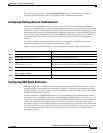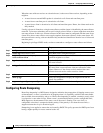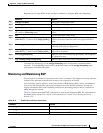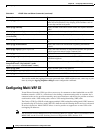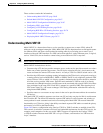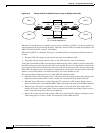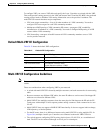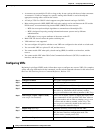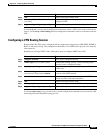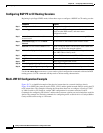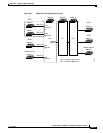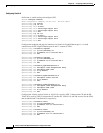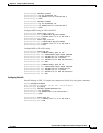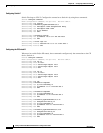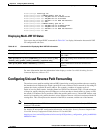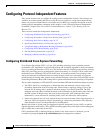
38-69
Catalyst 3750-E and 3560-E Switch Software Configuration Guide
OL-9775-02
Chapter 38 Configuring IP Unicast Routing
Configuring Multi-VRF CE
Use the no ip vrf vrf-name global configuration command to delete a VRF and to remove all interfaces
from it. Use the no ip vrf forwarding interface configuration command to remove an interface from the
VRF.
Configuring a VPN Routing Session
Routing within the VPN can be configured with any supported routing protocol (RIP, OSPF, EIGRP, or
BGP) or with static routing. The configuration shown here is for OSPF, but the process is the same for
other protocols.
Beginning in privileged EXEC mode, follow these steps to configure OSPF in the VPN:
Use the no router ospf process-id vrf vrf-name global configuration command to disassociate the VPN
forwarding table from the OSPF routing process.
Step 9
end Return to privileged EXEC mode.
Step 10
show ip vrf [brief | detail | interfaces]
[vrf-name]
Verify the configuration. Display information about the
configured VRFs.
Step 11
copy running-config startup-config (Optional) Save your entries in the configuration file.
Command Purpose
Command Purpose
Step 1
configure terminal Enter global configuration mode.
Step 2
router ospf process-id vrf vrf-name Enable OSPF routing, specify a VPN forwarding table,
and enter router configuration mode.
Step 3
log-adjacency-changes (Optional) Log changes in the adjacency state. This is the
default state.
Step 4
redistribute bgp
autonomous-system-number subnets
Set the switch to redistribute information from the BGP
network to the OSPF network.
Step 5
network network-number area area-id Define a network address and mask on which OSPF runs
and the area ID for that network address.
Step 6
end Return to privileged EXEC mode.
Step 7
show ip ospf process-id Verify the configuration of the OSPF network.
Step 8
copy running-config startup-config (Optional) Save your entries in the configuration file.



